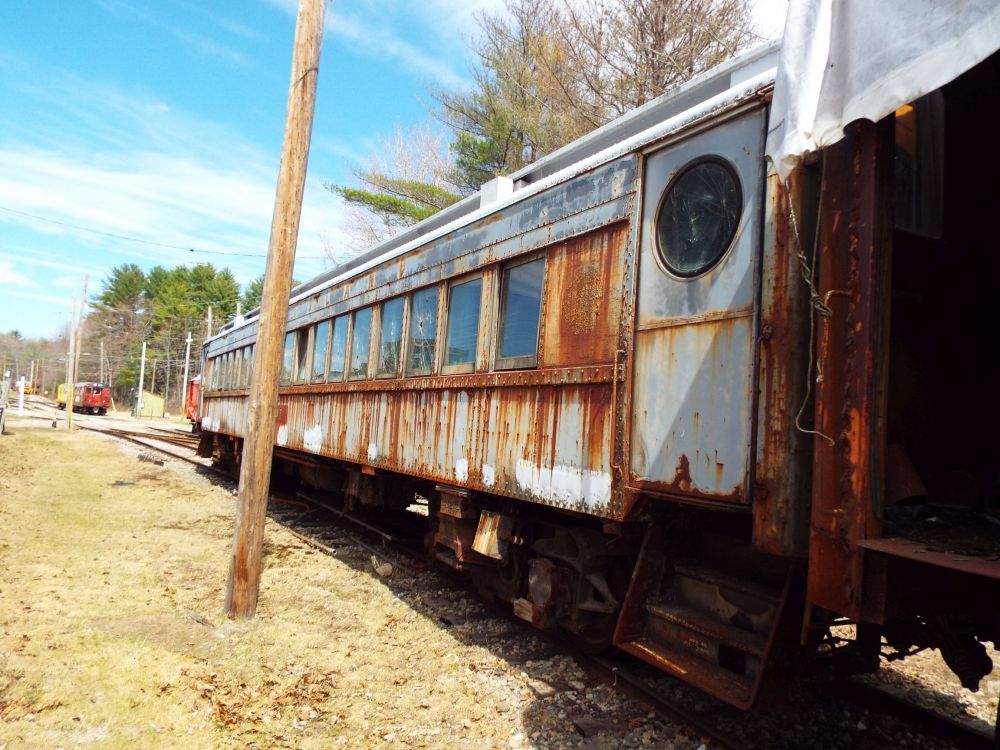
Kenyon F. Karl on 04/17/17
- Builder
- American Car & Foundry Co.
- Description
- Class MP54A1 commuter rail coach
- Type
- Railroad Equipment
- Year
- 1930
- Retired from Service
- 1971
- Acquired by the Museum
- 1972
- Note
- No. 4137 is badly rusted. It appears to require extensive restoration, including repainting and glass renewal.
Long Island Rail Road 4137
From New York
History
This car is one of over 900 MP54 electric-powered passenger cars that carried commuters between Long Island suburbs and New York City. The Long Island Rail Road was the first steam railroad to extensively electrify its operations. Its first electric operation was the line between Flatbush Avenue, Brooklyn and Jamaica, Queens using a fleet of 134 MP41 cars. George Gibbs designed these cars which were similar to the first all steel “Gibbs” cars for the Interborough Rapid Transit, one of which – No. 3352 – is at Seashore. The Long Island Rail Road acquired its first, larger, MP54 cars in 1908 to provide service to New York’s Pennsylvania Station, then under construction. The cars made the inaugural run into Pennsylvania Station when it opened in 1910. The LIRR continued acquiring MP54s until the final order of 45 cars from American Car & Foundry in 1930, which included No. 4137.
The MP54 designation refers to “Motor Passenger” and a passenger compartment 54 feet long. Top speed was 65 mph. The MP54 cars gave the Long Island Rail Road standardized efficiency but some thought they lacked comfort for riders. The cars were not air conditioned. While railroad coaches were rarely air conditioned in the 1930s, by the end of the MP54s service life, air conditioning was standard on most other commuter cars. The MP54s were known for their round porthole windows on the cars’ ends.
Beginning in 1915, the Pennsylvania Railroad, parent company of the Long Island Rail Road, acquired a fleet of almost 500 MP54s, nearly identical to the LIRR cars. However, the Pennsylvania MP54s received electric power from an overhead wire while the Long Island MP54s used an electrified third rail. Long Island and Pennsylvania Railroad MP54s were a familiar sight in cities between New York and Washington until their final operation in Philadelphia in 1981.
The Long Island Rail Road originally numbered this car No. 1137. The car first carried a Tuscan red paint scheme. The car received a light gray paint scheme about 1950. Then, when the LIRR modernized the car in 1958, it renumbered the car into the 4000 series, making this car No. 4137. The modernization raised the seating capacity from 72 to 89 by changing from two seats on each side of the aisle to 3-2 seating. At this time, the LIRR also applied dark gray paint on the car sides and orange paint on the car ends for improved visibility. Some newer LIRR MP54s had an arch roof, but No. 4137 has the traditional monitor roof. The last LIRR MP54s ran in 1971, replaced by M-1 “Metropolitan” cars.
After the end of service, the LIRR scrapped most of its MP54s and stored a few for possible preservation. While stored at Belmont, vandals threw rocks at the cars, which may be the source of the broken windows now on No. 4137. Seashore acquired No. 4137 in 1972. The museum did some structural restoration on No. 4137 in the 1990s.
Technical Information
- Seats: 89
Trucks
- Number: 2
- Model: 12DP)8P1/2CP3
Motor
- Number: 2
- Manufacturer: General Electric
- Model: 703
Weight and Dimensions
- Length: 65’ 0.00"
- Width: 10’ 4.00"
- Height: 13’ 6.00"
- Weight: 121950 lbs.
Additional Images

Kenyon F. Karl on 04/17/17
© 1998 - 2025 New England Electric Railway Historical Society. All Rights Reserved.